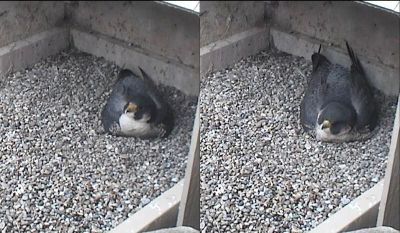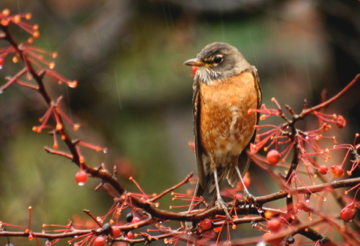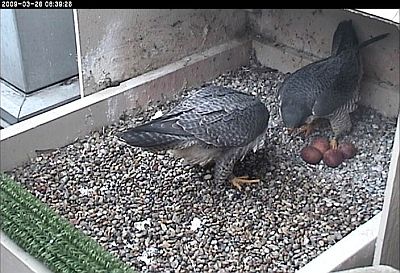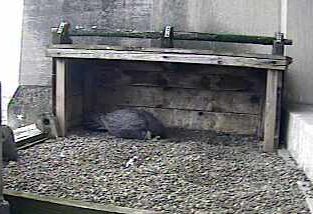 When I describe the activities of the Pitt peregrines people often ask me, “How do you tell them apart? Which one is Dorothy? Which is E2 (the male)?”
When I describe the activities of the Pitt peregrines people often ask me, “How do you tell them apart? Which one is Dorothy? Which is E2 (the male)?”
Unlike many songbirds male and female peregrine falcons look alike. The main difference between the sexes is their size – the female is up to 30% larger than the male – but this is only useful when you see them side by side. Even then they can fool you if the male has puffed out his feathers and the female has not.
So how to tell?
Thanks to the webcam at the University of Pittsburgh nest we’re able to take a closer look and – this may sound incredible – Dorothy’s and E2’s faces are different. When you know what to look for they’re recognizable just the way humans are.
To show you what I mean I captured some screenshots of both birds in similar poses and placed them side by side. In the composite above E2 is on the left, Dorothy is on the right. (There is another composite photo too, if you click on this one.)
First, the easiest sign: Look at their foreheads. E2 has a line of white feathers where his beak meets his forehead. Dorothy’s forehead is all gray. Last year I remarked that the yellow on E2’s beak looked “longer” but it’s his white forehead that causes that illusion. (Thanks to Nora on the Cleveland Falcon Forums for putting a name to this feature.)
Expanding the comparison: Look at their heads. E2’s looks more square or angular, partly because of his white forehead, and his eyes aren’t in shadow. Dorothy’s head is rounder on top, her eyes are more deeply set and her eyebrow line is sharper. My friend Karen says this makes Dorothy’s eyes look fierce.
Finally, it’s clear in the composite photos that E2 is smaller than Dorothy. When he sits in this position his tail lies flat on the gravel while Dorothy’s body is so long that her tail hits the back wall of the nest box and she bends it to the side.
Armed with these clues you’ll have many chances to observe Dorothy and E2 as they incubate their eggs in the coming weeks. See if you can tell the difference.
Keep in mind the facial differences apply only to these individual birds, not to all peregrines, and that you would never see this without a webcam. When peregrines fly or perch the only way to tell the sexes apart is by their size.
(photos from National Aviary webcam at University of Pittsburgh)
 Even before dawn I could hear the robins singing. Last night a large flock filled the trees near my house and sang their very best songs. I thought they would leave overnight but they were here to greet the morning, too.
Even before dawn I could hear the robins singing. Last night a large flock filled the trees near my house and sang their very best songs. I thought they would leave overnight but they were here to greet the morning, too.



 Last Sunday I drove up Interstate 79 to Moraine State Park, hoping to duplicate the wonderful bird moments I experienced there a week ago.
Last Sunday I drove up Interstate 79 to Moraine State Park, hoping to duplicate the wonderful bird moments I experienced there a week ago. 
